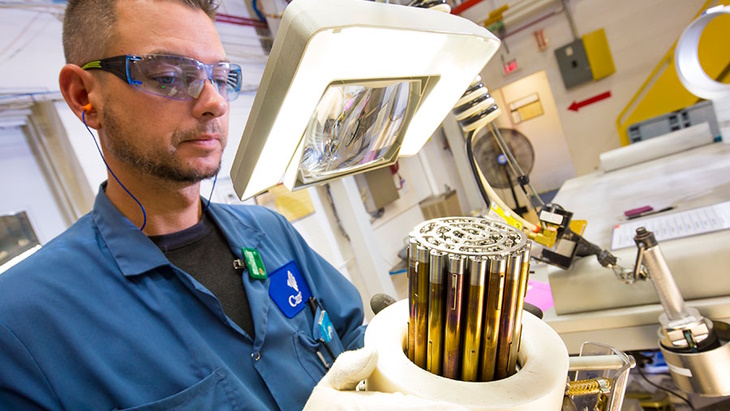The Canadian Nuclear Safety Commission (CNSC)'s authorisation of the 20-year renewal of Cameco Fuel Manufacturing's (CFM) operating licence for the facility at Port Hope in Ontario also includes an increase to the plant's annual production limit.

Inspecting a fuel bundle at the CFM facility (Image: Cameco Fuel Services)
CFM is licensed to produce uranium dioxide (UO2) fuel pellets and nuclear fuel bundles at the plant, where natural UO2 powder is pressed into pellets, fitted into zirconium tubes and then assembled into fuel bundles. The facility has been in operation since the late 1950s and came into Cameco's ownership in 2006 through the company's acquisition of Zircatec Precision Industries Inc. Zircatec was renamed Cameco Fuel Manufacturing Inc. in 2008.
The 20-year licence provides the regulatory certainty needed to enable the facility to safely provide this fuel for the next two decades, CFM said.
CNSC granted the licence renewal following a public hearing which took place in November. The renewal authorises CFM to possess, transfer, use, process, import, package, transport, manage store and dispose of the nuclear substances that are required for, associated with, or arise from CFM’s activities, and is valid from 1 March 2023 until 28 February 2043, at which point CFM may request another renewal. The renewed licence also requires CFM to conduct a "comprehensive" mid-way operational performance review by 2033 at the latest, in addition to the regulatory oversight report meeting and compliance verification activities which are carried out annually.
As part of the licence renewal, CNSC has also authorised increase of the plant's annual production limit to 1,650 tonnes of uranium (tU), as UO2 pellets, which is about 24% higher than the limit in the current licence. The increase aligns with the capacity of the current plant equipment and will mean the facility would be allowed to operate at 100% of its existing capability. CFM said it does not expect to use this capacity in the near future, but the increase in licenced capacity will give it additional capability "to respond to rises in customer demand created by the global and Canadian transition to net zero".
"The 20-year licence term reflects the strength and robustness of Canada's regulatory framework and the strong safety and environmental performance of CFM's operations,” Dale Clark, vice-president of Cameco Fuel Services Division, said. “We are also grateful to the community and all the intervenors who showed their support for CFM."
The CNSC last year granted a request from Cameco for a one-year licence renewal for the facility - to 28 February this year - to avoid a clash with licensing activities for the company's Blind River Refinery, which had been scheduled to occur at the same time.
The Port Hope facility is located on the traditional territory of the Wendat, Mississauga, Haudenosaunee, Anishinabek Nation, and the territory covered by the Williams Treaties First Nations.
Researched and written by World Nuclear News